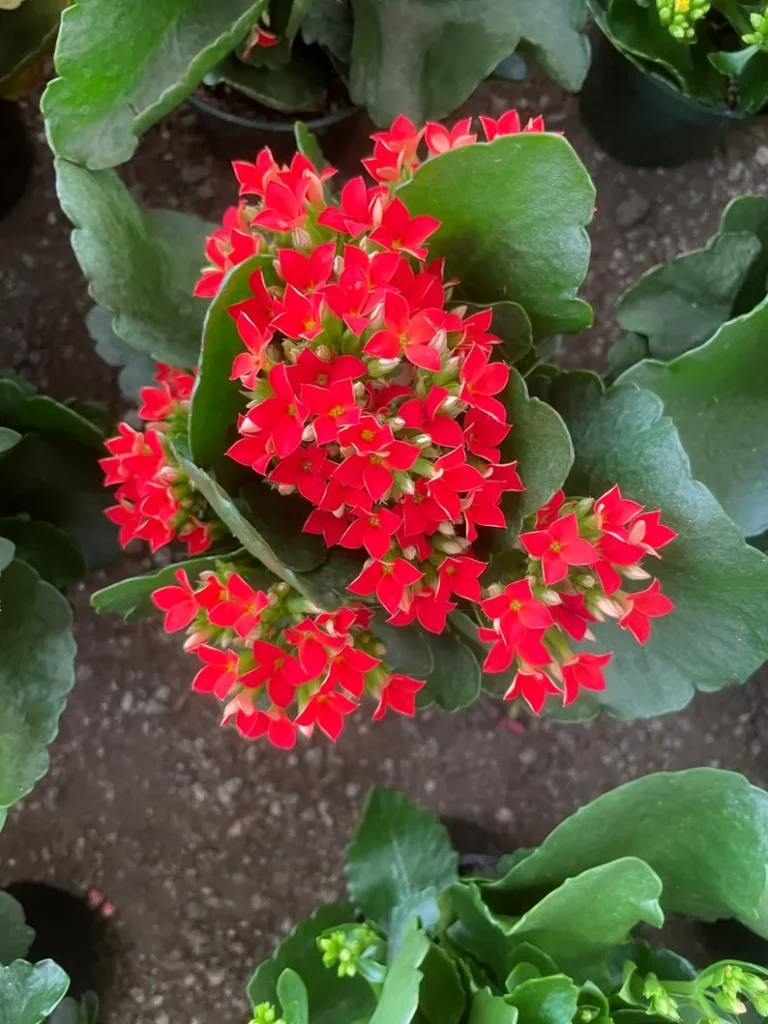Kalanchoe Succulent Care
Succulents are incredibly easy-going, low-care houseplants– great for beginners! Their foliage can range in shape, size, and color and they’ll make a great addition to a sunny window in your space.

How to care for your Kalanchoe Succulent
- LIGHT
Your plant will need plenty of bright light to bloom. It will do best by a sunny south or west window.
- WATER
Allow the Flowering Kalanchoe’s soil to become 100% dry between waterings. Be careful not to overwater as their roots are prone to root rot. Water slowly, allowing it to soak into the soil, until liquid flows through the drainage hole at the bottom of the pot. Discard any water that has accumulated in the saucer.
- HUMIDITY
Flowering Kalanchoe plants do not need high humidity to thrive. These plants will do well in average household humidity.
- TEMPERATURE
Your plant will thrive in rooms with temperatures between 55-80°F.
- FOOD
Feed your plant with a well-balanced fertilizer about once per month during the spring and summer months.
- TOXICITY
Flowering Kalanchoe plants are considered to be toxic to pets.
- ADDITIONAL CARE
To help the Flowering Kalanchoe rebloom, place it in complete darkness at night for 12-14 hours (closets work best) and then bright light for 10-12 hours. Also, pinch back or cut dead flowers to encourage more blooms.
Common Issues for your Kalanchoe Succulent
Natural Dormancy
Kalanchoe plants can flower for a few months at a time, but it is natural for them to lose their flowers at some point because they need some rest to rebloom. Depending on the time of year and length of the days, they will go into this dormancy period. Typically, at the end of summer or early fall, they will lose their leaves and begin producing new buds. Once the days become longer in the late winter, early spring, the buds will bloom into gorgeous flowers. Don’t fret if your plant’s flowers die off. It will rebloom in time. Just be sure to give your plant enough light in the spring so it will begin to flower. A south or west window is ideal.
Old Blooms
If there are dead flowers left on a Kalanchoe plant then it might be wasting its energy trying to sustain a part of the plant that is already dead. By cutting or pinching away the dead flowers the plant will begin to use its energy to produce new buds, replacing the dead flowers.
Watering Issues
The Kalanchoe plant is quite low maintenance and should only be watered when the soil is fully dry. Don’t allow the plant to become so dry it begins to wilt. Wilting can greatly affect future flower production. Also be sure not to overwater the plant, as this can lead to issues like root rot. Check the soil regularly to see if it needs a drink! If the soil is 100% dry, you can water.
How to Trick Your Plant Into Flowering
If you don’t want to wait for spring you can encourage the Kalanchoe to bloom at any time of year. You can do this by controlling the amount of light the Kalanchoe gets, encouraging it to bud and bloom. Try placing the Kalanchoe in a dark closet for 12-14 hours per day and back into bright light for the remaining 10-12 hours. If this method is successful you will see buds in 6-8 weeks.
Lack of Sunlight
One of the main reasons a Kalanchoe plant looks leggy and is growing too tall is because it is not receiving enough sunlight to encourage healthy growth. This process is known as “etiolation”. This is a common issue with indoor Kalanchoe plants and other succulents. The Kalanchoe plant will begin reaching towards the sunlight, becoming leggy-looking and a bit scraggly.
Move the Kalanchoe plant to a spot with more natural light so it no longer feels the need to stretch towards the sunlight. This can help produce healthier buds and blooms, resulting in the plant looking ‘fuller’.
Proper Pruning
If your Kalanchoe is looking leggy but is getting plenty of sunlight, then the leggy look could be caused by too many dead flowers. Dead flower branches still attached to the Kalanchoe plant can cause the plant to stop growing in a healthy way. Prune the Kalanchoe plant from the crown down, removing dead leaves, flowers, and branches. This allows the plant to focus its energy on healthy new growth.
Watering Issues
When your Kalanchoe plant is looking a bit leggy, check its soil for moisture. Every few days test the soil with your finger, when the soil has dried 100% you can give it more water. Overwatering can cause root rot, and underwatering can cause wilting, both of which affect healthy growth.
